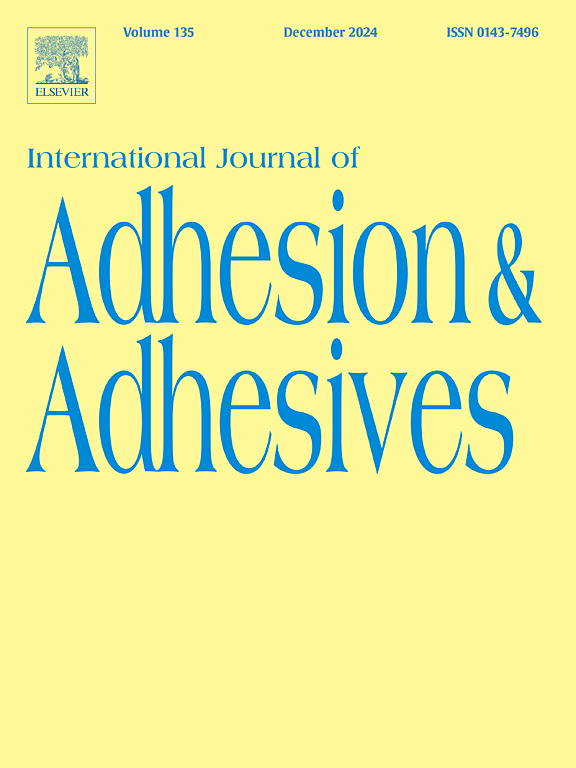Slow-growth damage of bonded composite-metal joints subjected to fatigue loading
IF 3.2
3区 材料科学
Q2 ENGINEERING, CHEMICAL
International Journal of Adhesion and Adhesives
Pub Date : 2025-02-08
DOI:10.1016/j.ijadhadh.2025.103979
引用次数: 0
Abstract
This study investigates the slow-growth damage of bonded composite-metal (CFRP-Aluminium) hybrid double lap joints. First, static tension tests were conducted to measure the residual strength of the partially disbonded joints. Finite element models were developed to predict the residual strength as a function of disbond crack length. The model was calibrated using the static test results and the characteristic distance method. Then, constant amplitude fatigue tests were conducted at a practical load range, determined on the basis of joint static strength and safety factor requirements, to measure disbond growth rates and joint fatigue life. Further numerical analyses were conducted, where the extended finite element method (XFEM) and virtual crack closure technique (VCCT) were applied to predict energy release rates at the disbond crack tip of the joints. The crack growth rates measured from the fatigue tests and the energy release rates from the parametric numerical analyses consistently indicated that slow-growth behaviour was present. By combining the crack growth rates and energy release rates, modified Paris laws were established to predict the disbonded crack growth and fatigue life of the joints with satisfactory results obtained. In addition, an important observation was made, that is, in the fatigue tests the disbond from the taper end would not migrate to generate delamination, the mechanism of which was convincingly revealed by a detailed FEM analysis. This study successfully implemented the proposed framework for the slow growth damage prediction of adhesively bonded joints and demonstrated its effectiveness.
疲劳载荷作用下复合材料连接接头的慢生长损伤
研究了复合金属复合材料(cfrp -铝)复合双搭接接头的慢生长损伤。首先,进行静拉伸试验,测量部分分离接头的残余强度。建立了有限元模型来预测残余强度作为脱离裂纹长度的函数。利用静态试验结果和特征距离法对模型进行了标定。然后,根据接头静强度和安全系数要求,在实际载荷范围内进行恒幅疲劳试验,测量接头的脱粘生长速率和疲劳寿命。采用扩展有限元法(XFEM)和虚拟裂纹闭合技术(VCCT)预测了接头脱离裂纹尖端的能量释放率。疲劳试验测量的裂纹扩展速率和参数数值分析的能量释放速率一致表明存在慢扩展行为。结合裂纹扩展速率和能量释放速率,建立修正的Paris定律来预测接头的分离裂纹扩展和疲劳寿命,取得了满意的结果。此外,还观察到在疲劳试验中,从锥度端剥离不会迁移产生分层,并通过详细的有限元分析令人信服地揭示了其机理。本研究成功地实现了所提出的粘接接头慢生长损伤预测框架,并证明了该框架的有效性。
本文章由计算机程序翻译,如有差异,请以英文原文为准。
求助全文
约1分钟内获得全文
求助全文
来源期刊

International Journal of Adhesion and Adhesives
工程技术-材料科学:综合
CiteScore
6.90
自引率
8.80%
发文量
200
审稿时长
8.3 months
期刊介绍:
The International Journal of Adhesion and Adhesives draws together the many aspects of the science and technology of adhesive materials, from fundamental research and development work to industrial applications. Subject areas covered include: interfacial interactions, surface chemistry, methods of testing, accumulation of test data on physical and mechanical properties, environmental effects, new adhesive materials, sealants, design of bonded joints, and manufacturing technology.
 求助内容:
求助内容: 应助结果提醒方式:
应助结果提醒方式:


